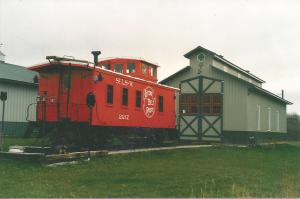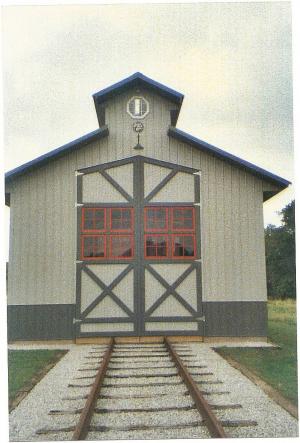Restored Caboose Has Its Own Track, Building
We’ve heard about folks restoring old train cabooses, but Jerry Mennenga has taken it another step by building a track for his caboose. About 45 ft. of the 110-ft. long track is inside a 24 by 64-ft. building Mennenga built to house the caboose. On nice evenings or when he entertains, he rolls the caboose outside from the caboose’s cupola to enjoy the view and wildlife on his rural Iowa property.
The train enthusiast purchased the caboose in 1978 and stayed in it when he and his wife volunteered at a Midwest railroad museum. Moving it to their Iowa property in 2009 took some heavy equipment. After removing the cupola, the body of the 42,000-lb. caboose was lifted off its trucks onto a low-bed trailer. The cupola and trucks were placed on another flatbed and transported to Iowa, where the track was waiting.
Mennenga, a retired industrial arts teacher, had leveled a spot and spread ballast stone for drainage. He purchased rail, ties and spikes that area rail lines no longer used, and laid the track with the help of friends.
Once the caboose was unloaded and reassembled on the track, Mennenga and his friends constructed the building and started restoration.
“The building’s end doors that allow the caboose to be moved in or out were modeled after the doors of a 1906 Chicago and Northwestern Railroad roundhouse in Wisconsin,” Mennenga says. “It took a block and tackle, two hydraulic jacks and 8 people to hang each of the 300-lb. doors. This allowed the caboose to spend its first winter under cover in 85 years.”
The “Cotton Belt Route” caboose was built in 1925 in Pine Bluff, Ark., and spent its first 20 years on the St. Louis Southwestern Railway. Later it was used in upper Michigan from 1945 until 1963.
By the time Mennenga set it on his property, the exterior needed a lot of work. He spent 30 to 40 hrs. removing rust and paint from the iron parts by needle-scaling, using a pneumatic hammer. He installed new vertical tongue and groove siding, insulated, built new windows and replaced roof walk boards. He finished the exterior by brushing on three coats of red paint.
“The interior is approximately 90 percent original,” Mennenga says. “Some upgrades (such as a dining nook) were made for modern convenience. Now that the restoration is completed, the building protects the caboose from sun and weather damage – helping to maintain its ‘better than new’ appearance.”
The 36 by 9-ft. caboose has four bunks, a stove, lockers, storage space and a ladder going to the cupola where benches for four people provide an elevated view.
“Now that I’m finished working on it, we can go out and enjoy it,” Mennenga says. “We can gaze out, watch the wildlife and imagine being on a train.”

Click here to download page story appeared in.
Click here to read entire issue
Restored Caboose Has Its Own Track Building FARM HOME Novelty Items We’ve heard about folks restoring old train cabooses but Jerry Mennenga has taken it another step by building a track for his caboose About 45 ft of the 110-ft long track is inside a 24 by 64-ft building Mennenga built to house the caboose On nice evenings or when he entertains he rolls the caboose outside from the caboose’s cupola to enjoy the view and wildlife on his rural Iowa property The train enthusiast purchased the caboose in 1978 and stayed in it when he and his wife volunteered at a Midwest railroad museum Moving it to their Iowa property in 2009 took some heavy equipment After removing the cupola the body of the 42 000-lb caboose was lifted off its trucks onto a low-bed trailer The cupola and trucks were placed on another flatbed and transported to Iowa where the track was waiting Mennenga a retired industrial arts teacher had leveled a spot and spread ballast stone for drainage He purchased rail ties and spikes that area rail lines no longer used and laid the track with the help of friends Once the caboose was unloaded and reassembled on the track Mennenga and his friends constructed the building and started restoration “The building’s end doors that allow the caboose to be moved in or out were modeled after the doors of a 1906 Chicago and Northwestern Railroad roundhouse in Wisconsin ” Mennenga says “It took a block and tackle two hydraulic jacks and 8 people to hang each of the 300-lb doors This allowed the caboose to spend its first winter under cover in 85 years ” The “Cotton Belt Route” caboose was built in 1925 in Pine Bluff Ark and spent its first 20 years on the St Louis Southwestern Railway Later it was used in upper Michigan from 1945 until 1963 By the time Mennenga set it on his property the exterior needed a lot of work He spent 30 to 40 hrs removing rust and paint from the iron parts by needle-scaling using a pneumatic hammer He installed new vertical tongue and groove siding insulated built new windows and replaced roof walk boards He finished the exterior by brushing on three coats of red paint “The interior is approximately 90 percent original ” Mennenga says “Some upgrades such as a dining nook were made for modern convenience Now that the restoration is completed the building protects the caboose from sun and weather damage – helping to maintain its ‘better than new’ appearance ” The 36 by 9-ft caboose has four bunks a stove lockers storage space and a ladder going to the cupola where benches for four people provide an elevated view “Now that I’m finished working on it we can go out and enjoy it ” Mennenga says “We can gaze out watch the wildlife and imagine being on a train ”








